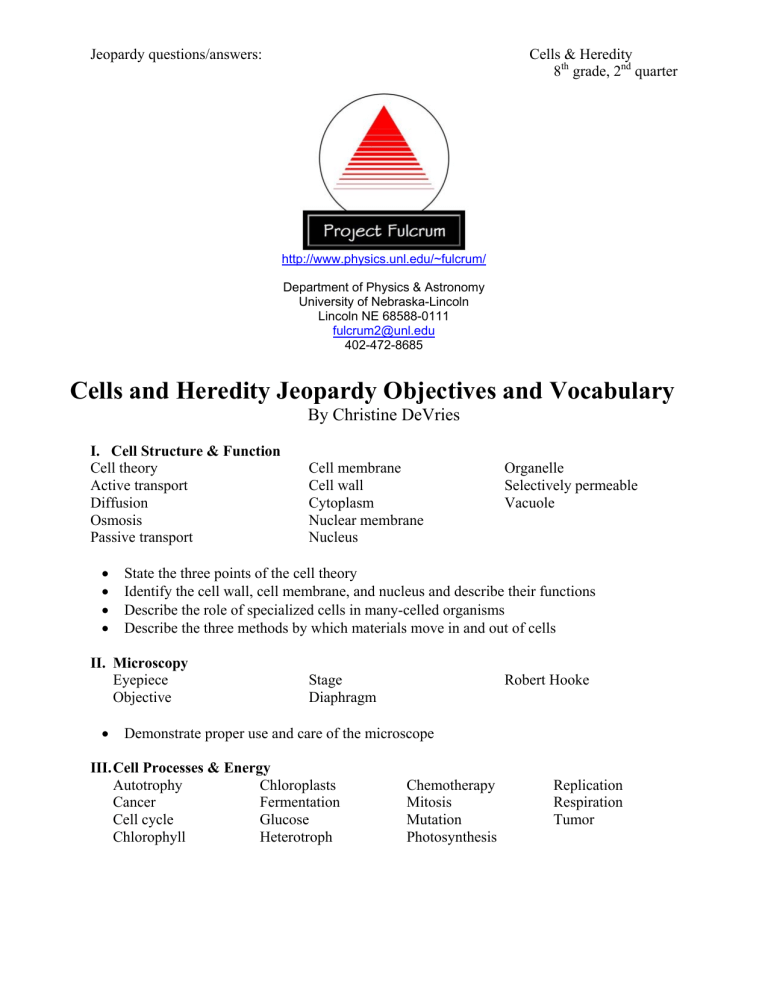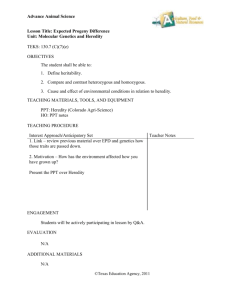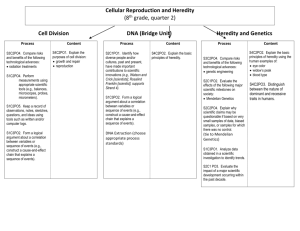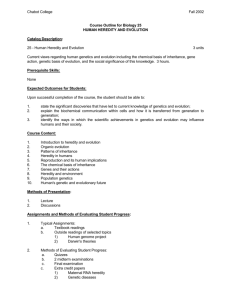Cells and Heredity Jeopardy Objectives and Vocabulary

Jeopardy questions/answers: Cells & Heredity
8 th
grade, 2 nd
quarter http://www.physics.unl.edu/~fulcrum/
Department of Physics & Astronomy
University of Nebraska-Lincoln
Lincoln NE 68588-0111 fulcrum2@unl.edu
402-472-8685
Cells and Heredity Jeopardy Objectives and Vocabulary
By Christine DeVries
I. Cell Structure & Function
Cell theory
Active transport
Diffusion
Cell membrane
Cell wall
Cytoplasm
Organelle
Selectively permeable
Vacuole
Osmosis
Passive transport
Nuclear membrane
Nucleus
•
State the three points of the cell theory
•
Identify the cell wall, cell membrane, and nucleus and describe their functions
•
Describe the role of specialized cells in many-celled organisms
•
Describe the three methods by which materials move in and out of cells
II.
Microscopy
Eyepiece Stage
Objective Diaphragm
•
Demonstrate proper use and care of the microscope
III.
Cell Processes & Energy
Autotrophy Chloroplasts Chemotherapy
Robert Hooke
Cancer
Cell cycle
Chlorophyll
Fermentation
Glucose
Heterotroph
Mitosis
Mutation
Photosynthesis
Replication
Respiration
Tumor
Jeopardy questions/answers: Cells & Heredity
8 th
grade, 2 nd
quarter
•
Describe the process of photosynthesis and explain how the sun supplies energy to all living things
•
Describe the relationship between photosynthesis and respiration
•
State the relationship between cancer and the cell cycle
IV.
Genetics: The Science of Heredity
Alleles Genes Hybrids
Dominant Chromosome Purebred
Gregor Mendel Heredity Recessive
•
Identify the factors that control the inheritance of traits and how Mendel applied them
•
State the role of chromosomes in inheritance
•
Describe how the process of meiosis forms sperm and egg cells
•
Investigate and examine the issue of genetic testing
Jeopardy questions/answers: Cells & Heredity
8 th
grade, 2 nd
quarter
Jeopardy!
Cell Structure & Function
The liquid inside the cell, mostly water
It is the boundary of the cell; it controls what substances enter or leave the cell
“Control center of the cell” where genetic material (DNA) is found
The nonliving border that surrounds plant cells, made of cellulose
The three methods by which materials move in and out of cells
Microscopy & Miscellany
The part indicated below:
The part indicated below:
The part indicated below:
The part indicated below:
This scientist discovered cork cells
Cell Processes & Energy
The ultimate source of energy for all living things
The dye molecule necessary for photosynthesis
The disease associated with improper cellular replication
The two products of photosynthesis
This term refers to the step of the cell cycle between Interphase and Cytokinesis
Genetics
Humans have 46 of these
Tt (Another word for heterozygous)
Represented by CAPITAL letters; responsible for phenotype
TT, tt (Another word for homozygous)
The “father of modern genetics”
Double Jeopardy
Cell Structure & Function
A storage sac for water or other materials
This general term describes all the small structures within a cell
The two structural differences between plant and animal cells.
Name of this thin structure:
This term describes the cell membrane’s ability to allow only some materials through
Microscopy & Miscellany
Cells that carry out a specific function
Holding the arm and the base
This type of light microscope has multiple lenses
The product used for cleaning the glass parts of a microscope
This Dutch businessman was first to see bacteria with his simple microscopes
Jeopardy questions/answers: Cells & Heredity
8 th
grade, 2 nd
quarter
Cell Processes & Energy
A collection of cancer cells
Food is broken down and energy is evolved in this process
This general term describes the use of chemicals to treat cancer
This term refers to an organism that can not create its own food
The cell shown below is in the midst of this step of mitosis:
Genetics
“The genetic transmission of characteristics from parent to offspring.”
Represented by lower case letters; must be purebred to be phenotype
One of the traits determined by a specific gene (Ex. Tall/short, green/yellow, et cetera)
Meiosis forms these cells
Genes are composed of this biomolecule
Final Jeopardy
Correctly Identify 6 parts
The Six (6) Characteristics of Living Things
The three points of The Cell Theory
A reason to perform genetic testing








